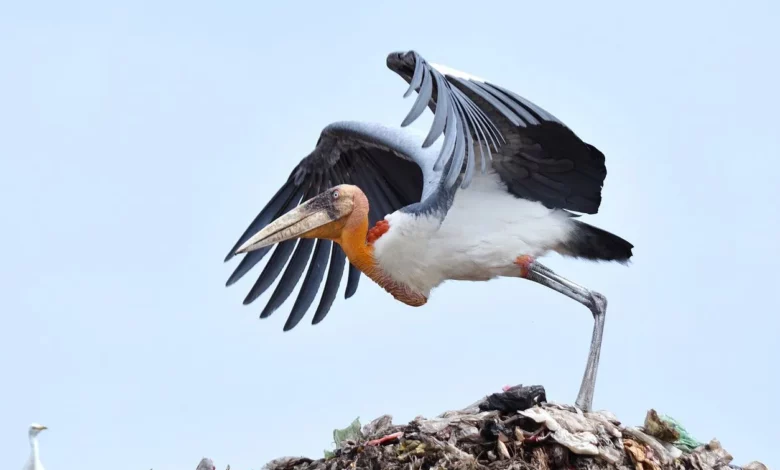
“Till then, I had only seen its smaller species, the Lesser Adjutant,” Mishra, who has since turned into a conservationist of theLesser Adjutant, told 101Reporters.
Around 100 of them could be seen across four to five districts of Bihar until 2007. Their main breeding spot was Kadwa Diyara, located 250 km from State capital Patna. “But just as in other Asian countries, their numbers started to dwindle, which set alarm bells ringing for us,” noted Mishra, also the state coordinator of the Indian Bird Conservation Network.
He launched conservation efforts through his Mandar Nature Club, but ensuring community participation was key to his success. That was quite a challenging aspect as the bird, commonly known as garuda in the region, was not popular among the people.
The bird’s above-five-foot frame, its grunt, balding looks, the enormous amounts of poop it generated, and the damage it caused to the crops worked against it. Moreover, it was an easy target for hunters due to its big size.
But Mishra and the team were determined to make people understand that the garuda is an endangered species. It is on the International Union for Conservation of Nature’s Red List of Threatened Species and is also listed under Schedule IV of the Indian Wildlife (Protection) Act, 1972. At present, the bird is found only in Cambodia, Assam and Bhagalpur.
With consistent efforts, the number of Greater Adjutants in Bihar has increased to nearly 700 in 2019 from just 75-80 in 2006, according to Mishra. The latest numbers will be known in February 2023.
Apart from Kadwa Diyara panchayat, Ashram Tola, Kasimpur, Lakhminiya, Bagri Tola and Pratapnagar in neighbouring Khairpur panchayat have a sizeable population of garudas. Its smaller species are found in other areas.
Awareness drives change
Initially, Mandar Nature Club worked with people in various panchayats to create awareness about the bird. “I set up chaupals to connect villagers with the issue. We felicitated people who joined the conservation activities. ‘Garuda Saviours’ and ‘Garuda Guardians’ were designated through such efforts, which later made the village synonymous with the bird’s conservation,” Mishra said.
Gyan Chandra Gyani, an environmentalist in Bhagalpur district, told 101Reporters that the environment and availability of food and water made Kadwa Diyara an ideal home for garudas. “We are seeing a constant increase in their numbers, thanks to the villagers who not only serve them but also protect them from hunters, electric wires and other threats.”
Kadwa Diyara native and veterinarian Nagina Rai attested to the villagers’ zeal for conservation. “Until two years ago, deaths of garudas after coming into contact with high voltage cables were common. However, public protests forced authorities to adopt underground cables.” She credits the contribution of Dipak Kumar Singh, the then-Principal Secretary of the Environment, Forest, and Climate Change Department, who worked very hard to make this happen.
In 2018, when a four-lane road construction began, the villagers opposed cutting down banyan trees, a favourite nesting spot of garudas. The course of the road was changed to protect the trees.
Rai informed 101Reporters that villagers also protect burflower trees, another popular nesting place of garudas. “Most of the people here are farmers. Though they collect wood from their ‘bageechas’ for personal use, they cut the trees down only under compelling circumstances because they want to ensure that garudas do not face an issue in building their nests.”
What is more, the villagers these days do not hesitate to give first aid to the birds in distress as they have received training in this regard.
Dr Rajiv Kumar, a resident doctor associated with Mandar Nature Club, told 101Reporters that poachers used to target the migratory birds that occupy the wetlands from October to February. Several nomadic tribes have the habit of consuming garuda eggs, too. So the villagers came together and restricted their entry into the village and informed the administration if they spotted any suspicious individuals or groups in their area.
A new identity
The Greater Adjutant has transformed Kadwa Diyara in many ways. “People initially complained that the large bird dirtied the area with its droppings and damaged their crops. Hence, they destroyed garuda nests by cutting down trees. Later, they learnt that garudas could protect their crops from rats. They also noticed that incidents of snakebites have come down, as garudas eat snakes, all of which gave the bird a new identity,” Dr Kumar said.
Shyamsundar gave a glimpse into how the village flourished after it became associated with the bird.
“Garuda has made us famous. Tourists now flock here. Around 25 new shops have come up. A shopkeeper can earn approximately Rs 5,000 per month from October to February. This gives us an extra income other than what we gain from agriculture. Today, garuda is a symbol of our village’s development,” he said.
Sunita (32) added that schoolchildren, people from other villages, and even a few foreigners, environmental officials and scientists come to see the village every year. Satyam Kumar (24) informed that two residents of Kadwa Diyara were feted at the Bhagalpur Bird Festival last year for their garuda conservation effort.
Reiterating the benefits, local politician Prashant Kumar Kanhaiya (28) said, “Everyone from all walks of life has contributed to making Kadwa Diyara panchayat a garuda haven. If the government showed some will by supporting those who are treating the birds for free or publicising the conservation efforts beyond the district and the state, things could get even better.”
Bhagalpur Divisional Forest Officer Bharat Chintapalli told 101Reporters that the conservation efforts have earned Kadwa Diyara the tag of ‘other effective area-based conservation measures’ (OECM), which classifies areas known to promote biodiversity.
“The OECM tag helps improve bird conservation efforts in a particular area. We are continuously working to develop garuda nesting spots in areas adjacent to Kadwa Diyara,” Chintapalli added.






